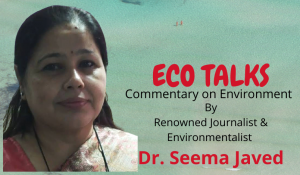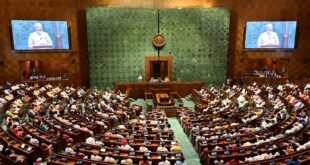 Today, the 54th Session of the IPCC accepted the work of the much anticipated Summary for Policymakers (SPM) of the Working Group I contribution to the Sixth Assessment Cycle(AR6), entitled Climate Change 2021: the Physical Science Basis.
Today, the 54th Session of the IPCC accepted the work of the much anticipated Summary for Policymakers (SPM) of the Working Group I contribution to the Sixth Assessment Cycle(AR6), entitled Climate Change 2021: the Physical Science Basis.
The Working Group I (AR6 WGI) report – finalised and approved by 234 authors and 195 governments – is the biggest update of the state of knowledge on climate science since therelease of the IPCC’s AR5 in 2014, and its landmark 1.5 Special Report (SR1.5).
The WGI report examines the physical underpinning of past, present, and future climate change. It looks at fundamentals such as how human-caused emissions are leading to fundamental planetary changes to the climate system. It also gives us an idea of how these changes have caused us to lock in climate impacts already at our current level of warming, as well as mapping how these impacts could worsen if temperatures and emissions continue to rise unchecked.
It is the biggest update of the state of knowledge on climate science since the release of AR5 in 2014.
The report covers topics like extreme weather, human attribution, the carbon budget, feedback cycles, and charts the future state of the climate. The WG1 report does not explicitly cover the impacts of climate change or mitigation, which will be the focus of the IPCC next reports published in 2022, called WG2 and WG3 respectively.

This briefing focuses on the IPCC’s WG1 summary for policymakers’ relevance to India.
Overall, the WG1 report focuses on the global impacts and signals of climate change. India is currently the world’s fourth largest greenhouse gas emitter (if the EU is counted as one block), but per capita emissions are much lower. The US emitted nearly 9 times more greenhouse gases per capita than India in 2018.
This report contains a much improved understanding of how humans are unequivocally responsible for the climate changes we have observed since pre-industrial times. There is no doubt that human activities have warmed the planet and that rapid and widespread changes have occured, and that some impacts are now locked in. It also concludes that our planet will continue to experience unprecedented change without drastic, deep, emissions reduction.
Globally, the planet will warm by 1.5°C in all scenarios. Even in the most ambitious emissions pathway, we will reach 1.5°C in the 2030s, overshoot to 1.6°C, before the temperature declines to 1.4°C at the end of the century. Based on our existing emissions trajectory SSP2-4.5 (considering the total ambition of climate pledges to date), we are on track for global temperature warming of at least 2.7°C by 2100. (Figure SPM4, panel a, page 17 and Table SPM1, page 18).
Latest climate science projects increased precipitation and more frequent hot extremes in India:
- Warming over India is projected to track the global average and the nation is expected to see an increase in frequency and severity of hot extremes .
- Globally, 1-in-10 year hot extreme events will occur 5 times more frequently at 2°C. At 4°C these 1-in-10 events will likely happen 9.4 times in a ten year period, nearly once a year on average.
- An increase in annual mean precipitation is projected. The increase in rainfall will be more severe over southern parts of India. On the southwest coast rainfall could increase by around 20%, relative to 1850-1900. If we warm by 4°C, India could see about a 40% increase in precipitation annually .
- Monsoon precipitation is projected to increase in the mid- to long term over South Asia
- Globally, severe, heavy precipitation events that now occur on average once every ten years, are projected to nearly double in frequency at 2°C (1.7 times in a ten year period). At 4°C, the likelihood of these events will jump to 2.7 times in a ten year period.
- The new report concludes with high confidence that human induced climate change is likely the main driver of both increasing hot extremes and heavy precipitation .
- Since the 1950s, human emissions have also increased the likelihood of ‘compound extreme events’ – which is the term for when multiple extremes happen at the same time. For example, more heat can trigger more drought, or can lead to more wildfires. Many regions around the world are projected to experience more of these compound events, and in the future compound events will be more frequent with higher global warming .
Reducing greenhouses gases and other short lived climate forcers will reduce air pollution and global warming, a “win-win” combination:
India is struggling with air pollution – in 2019 air pollution claimed 1.67 million lives in the country. 74% of low-income city workers in the nation are exposed to dangerously high levels of air pollution and the nation is home to 6 out of 10 of the world’s most polluted cities.
- AR6 is the first IPCC assessment to include a chapter (Chapter 6) dedicated to so-called ‘short-lived climate forcers’, like aerosols, particulate matter and other reactive gases (like ozone) that exist in the atmosphere for a few hours to a couple of months (they also include methane, which has a lifetime of about 12 years). Aerosols such as sulphur dioxide (SO2) and nitrous oxides (NO2) are responsible for air pollution and are often found in concentrated levels in cities.
- The report finds that strong and sustained reductions of methane emissions( according to India’s Third Biennial Update Report to UNFCCC, 2021) will be crucial to reducing global temperature rise and would improve air quality. Because aerosols and methane live for such a short time in the atmosphere we will see climate benefits very quickly if they are reduced. Reducing aerosols can lead to a small increase in warming – as they function as small reflective particulates in the atmosphere – while methane is a very potent greenhouse gas (28 to 36 times more than CO2 over a 100 year period). But, simultaneous reductions of the two counterbalance each other and will together lead to an overall increase in air quality and lower warming. In other words, reducing short lived gases is a “win-win” for the climate and public health (D.1.7).
Sea level rise will continue to rise over the 21st century:
- With 7,517km of coastline, India will face significant threats from rising seas. Across six Indian port cities – Chennai, Kochi, Kolkata, Mumbai, Surat and Visakhapatnam – 28.6 million people will be exposed to coastal flooding if sea levels rise 50cm, according to one study. The assets exposed to flooding will be worth about US$4 trillion. The areas of India that would be below sea-level with 1m of sea-level rise are shown on this map (this does not take into account current flood defences).
- The report concludes that global mean sea levels will continue to rise over the 21st century, even in the lowest emissions scenarios. This is because the warming of the ocean, as well as the melting of ice sheets and glaciers, act on slower timescales than the rest of the climate, and are still ‘catching up’ with even the current amount of warming.
- But we still have choices, the likely global mean sea level rise by 2100 is 0.28-0.55 m under the lowest emissions scenario (SSP1-1.9), this is much lower than compared to the very high scenario (SSP5-8.5), projected to see to 0.63-1.01 m sea level rise. Both are relative to 1995-2014 (B.5.3).
- Furthermore, in the highest emissions scenario global sea level rise above the likely range – approaching 2 m by 2100 and 5 m by 2150 – cannot be ruled out due to deep uncertainty in ice sheet processes (B.5.3).
Mountain glaciers are committed to continue melting for decades or centuries:
- In India, glaciers in the Hindu Kush Himalaya Region are a crucial water supply for the 240 million people who live in the region, including 86 million Indians – roughly the equivalent of the country’s five biggest cities combined. Glaciers such as in the Lahaul-Spiti region of western Himalaya have been losing mass since the start of the 21st century, and if emissions do not fall, glaciers in the Hindu Kush Himalaya would decline by two-thirds.
- The report finds that human influence is very likely the main driver of global retreat of glaciers since the 1990s and almost all of the world’s glaciers have retreated since the 1950s in an unprecedented manner (A1.5, A2.3).
- Mountain and polar glaciers are committed to continue melting for decades or centuries (B.5.2). Not only is glacier mass loss a dominant contributor to global mean sea level rise, it may also cause low-likelihood, high-impact outcomes, characterized by deep uncertainty and sometimes involving tipping points (B5.2).
 Jubilee Post News & Views
Jubilee Post News & Views





